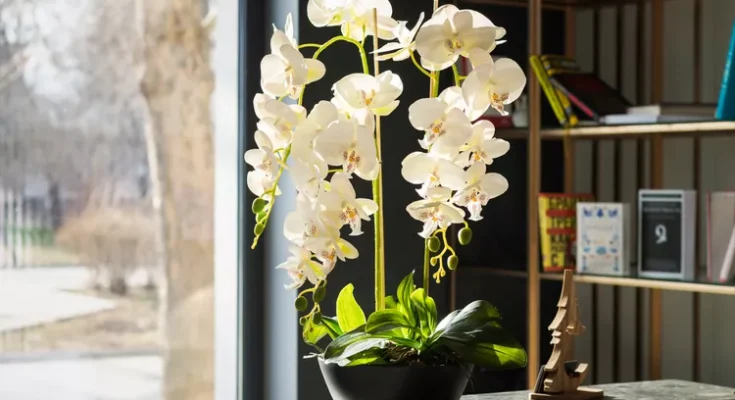The orchid family, Orchidaceae, is one of the largest plant families with an estimated 30,000 species and many more cultivars. There are hardy orchids that live in temperate climates, but 80 percent of orchids live in tropical conditions in Central and South America, Asia, and Africa. What we grow as houseplants are tropical in origin which is important to know—the plant’s natural environment indicates their desired cultural requirements. Here are the best types of orchids to grow at home.
About Orchids
Orchids are epiphytes, semi-terrestrial, or terrestrial. Epiphytes are plants that do not grow in soil. They are often found clinging to trees with thick, aerial roots. Terrestrial orchids grow on or in the ground. Most of the orchids we grow in the home are tropical epiphytes requiring a special orchid potting mix, high humidity, warmth, and bright light.
All orchid flowers are zygomorphic. If you look directly at the flower, you can only divide it in half along one plane so that the two halves are mirror images of each other. The flower has three outside sepals (looks like petals), two inside petals, and one labellum. The labellum is the prominent “lip” which is a modified petal serving as the landing platform for pollinators.
Tips For Growing Orchids
If orchids are new to you, don’t be intimidated by them. They may have a reputation for being finicky, but some varieties are easier to grow. These tips will ensure you have healthy plants that bloom for years to come.
- Give them indirect light. Too much sun can burn some varieties, so make sure any direct sunlight coming in is filtered and that they don’t get afternoon sun. East- and north-facing windows offer the best light.
- Orchids don’t require potting soil. Use sphagnum moss or bark or a commercial orchid mix for potting to ensure fast drainage and good airflow.
- If aphids attack your plant, spray the leaves with insecticidal soap. It will get rid of the aphids, but it won’t hurt your plant.
- Orchids like a humid environment. They thrive in temperatures of 72°F to 85°F during the day, and 60°F at night.
- They need balance to rebloom. Orchids bloom once a year in spring, and their blooms last for several months. To get them to rebloom, they need a balanced fertilizer twice a month. Increase exposure to light if they aren’t near a window, and keep them in a cooler spot, about 55°F to 65°F.
The Best Orchids For Houseplants
This alphabetical list of easy-to-grow orchids is made for all orchid enthusiasts. All are epiphytes except where noted. For each genus, look at the flower structure—the lip, the three outside sepals, and two inside petals—and you will begin to see the differences among them. Note too that you might not be purchasing the species for your home. You may be purchasing a cultivar within the genus—a plant with a name in single quotation marks that has been bred for particular characteristics.
Lady of the Night (Brassavola nodosa)
:max_bytes(150000):strip_icc():format(webp)/GettyImages-962585234-380abeaf285248a694fb334646c3cfbd.jpg)
- Botanical Name: Brassavola nodosa
- Sun Exposure: Full sun
- Soil Type: Well-drained
- Soil pH: Neutral, acidic
This flower is unusual in that it has a large broad white lip and very thin, pale green petals and sepals. There are about 1 to 6 blossoms, about 3 inches wide, on a 6-inch stem. The plant is relatively small, about 9 inches tall. The blossoms have a sweet fragrance. Lady of the Night needs bright light, warm temperatures, and high humidity. It should be watered regularly except during the winter when it may need a short dry period.
Moth Orchid (Phalaenopsis)
:max_bytes(150000):strip_icc():format(webp)/2046601_motho047_1-2000-66eca5df1ccb46148ffaab7ed2987fed.jpg)
- Botanical Name: Phalaenopsis
- Sun Exposure: Partial
- Soil Type: Moist, well-drained
- Soil pH: Slightly acidic
These are the most popular orchids sold for home use. They are easy to find at garden centers and big box stores and are often given as gifts. Flowers are arranged in a spray, last for months, and come in a variety of colors including a matte white. The petals and sepals are wide and flat with a relatively small lip. The plant can bloom several times a year and should be watered year-round. Although they can tolerate the low light in a home, it is best to grow them near an east-facing window with warm temperatures and about 50 percent humidity.
Spider Orchid (Brassia)
:max_bytes(150000):strip_icc():format(webp)/GettyImages-1423290477-4caaccebd98d4e26a5252ae96e6cfe40.jpg)
- Botanical Name: Brassia
- Sun Exposure: Bright, indirect light
- Soil Type: Well-draining
- Soil pH: Slightly acidic
This variety also has unusual flower shapes with large lips and narrow, string-like, sepals and petals up to 4 to 5 inches long. Flower colors can be green with yellow and brown markings and can be fragrant. The plants are about 10 inches tall. Spider orchids need bright light, intermediate to warm temperatures, and intermediate to high humidity. Water year-round but less often in the winter.
Corsage Orchid (Cattleya)
:max_bytes(150000):strip_icc():format(webp)/GettyImages-1155273208-045da41eba774d5d8e2a9c88e9f00971.jpg)
- Botanical Name: Cattleya
- Sun Exposure: Bright, indirect light
- Soil Type: Well-drained
- Soil pH: Acidic
These are the large, fragrant flowers often used for corsages. Usually, the lip is large, prominent with frilly edges and a contrasting color from the petals. The entire plant is not tall, but each flower is large, from 5 to 8 inches across. Cattleyas need bright light and intermediate warmth. The plants should be watered when growing and then sparingly when resting in fall and winter. There has been quite a lot of breeding with this genus so there are many different cultivars with a variety of color. These were very popular before the Phalaenopsis (Moth Orchid) gained attention.
Boat Orchid (Cymbidium)
:max_bytes(150000):strip_icc():format(webp)/GettyImages-1189450602-155aa0f4e43b4fb9b30b0cf018c8dbfd.jpg)
- Botanical Name: Cymbidium
- Sun Exposure: Indirect, filtered
- Soil Type: Loamy
- Soil pH: Slightly acidic
Called boat orchids because of the large boat-shaped lip, the cymbidiums are tall plants with large blossoms and prominent lips. The cymbidiums need bright light but cannot tolerate temperatures above 86 degrees, so they may have to stay indoors in areas with very hot summers. However, in areas with mild climates, they could live outdoors year-round in the shade. Plants can be 3 feet in height with blooms up to 4 inches across and about a dozen blossoms on a spike. The plant can produce more than one flower spike at a time, so it may look like the flowers are lasting even longer. There are many hybrids available, including fragrant varieties. They need water all year long.
Bamboo Orchid (Dendrobium)
:max_bytes(150000):strip_icc():format(webp)/GettyImages-1468130956-0dddfffbefd74f918bc1807ec1d1b88d.jpg)
- Botanical Name: Dendrobium
- Sun Exposure: Partial
- Soil Type: Moist, well-drained
- Soil pH: Acidic
Often called bamboo orchid since the pseudobulbs or stalks look like bamboo canes, this is a very large, diverse genus. It flowers in every color except blue and has great diversity in the shape. Foliage may be present along the cane or at the apex, and some plants are evergreen while others are deciduous. The two more popular ones are D. nobile and D. phalaenopsis. Related cultivars have rounded flower forms and 2 or 3 flowers at every node on the stem so there can be many flowers per stem.
D. nobile is about 18 inches tall, and foliage appears along the pseudobulb. It prefers bright light, warm temperatures, and 50 to 60 percent humidity. Water all summer long but not in winter. D. phalaenopsis is so named because the flowers are similar to Phalaenopsis (Moth Orchid). These plants are about 12 inches tall with foliage at the apex. The flower spikes are also produced at the apex and sprays consist of 5 to 10 blossoms about 3 inches wide. It prefers bright light, high humidity, and warm to hot temperatures. Water all summer long but not in the winter.
Jewel Orchid (Ludisia discolor)
:max_bytes(150000):strip_icc():format(webp)/GettyImages-1126244876-98b1a20bd37e4f49ad7675f500f30f97.jpg)
- Botanical Name: Ludisia
- Sun Exposure: Partial
- Soil Type: Well-drained
- Soil pH: Neutral, slightly acidic
This plant is grown for its beautiful foliage, like a tropical houseplant. The leaves are elliptical, velvet textured, and deep green with a red or pink cast and prominent venation. The foliage is only a few inches tall, but flower spikes rise above the foliage about 4 to 10 inches high. Individual flowers are small and white with a yellow lip. The plant tolerates low light but should be grown in bright light, high humidity, and intermediate to warm temperatures. Water year-round making sure it does not dry out. This is a terrestrial orchid that can grow in a container with a commercial potting mix.
Kite Orchid (Masdevallia)
:max_bytes(150000):strip_icc():format(webp)/GettyImages-103771900-a3c6684ebda84e1e9c89f2ac12e016e0.jpg)
- Botanical Name: Masdevallia
- Sun Exposure: Partial
- Soil Type: Well-drained
- Soil pH: Slightly acidic
The Kite Orchid has unusual flower shapes where the sepals are fused into a tube-like structure. It needs bright light and cool to intermediate temperatures, nothing higher than 80 degrees (do not bring outdoors in the summer). Water often, do not let it dry out completely, and provide high humidity. Try growing the modern cultivars for better success in the home.
Pansy Orchid (Miltonia and Miltoniopsis)
:max_bytes(150000):strip_icc():format(webp)/GettyImages-1465474046-258bad55896140a8bf8786c9b506d852.jpg)
- Botanical Name: Miltonia and Miltoniopsis
- Sun Exposure: Partial
- Soil Type: Well-drained
- Soil pH: Neutral, acidic
At one point the only genus was Miltonia, but then taxonomists pulled a group out and classified them as Miltoniopsis. Orchids in the Miltonia genus are primarily from Brazil and prefer warmer temperatures than the orchids in the Miltoniopsis genus, which originate from cool regions in Costa Rica, Panama, Venezuela, Ecuador, and Columbia. The Miltonias need more light than the Miltoniopsis. Miltonias prefer to be dry between waterings while Miltoniopsis like to be evenly moist. The plants can be about 18 inches tall; flowers can be up to 4 inches across. Flower shapes and colors can vary but, particularly with Miltoniopsis, they are pansy-like with markings resembling the pansy face and large lips compared to the upper petals and sepals.
Dancing Ladies (Oncidium)
:max_bytes(150000):strip_icc():format(webp)/GettyImages-137993669-73b68f1e61194b788e61a6aab9f7ff8a.jpg)
- Botanical Name: Oncidium
- Sun Exposure: Partial, full
- Soil Type: Well-drained
- Soil pH: Acidic
This is a large genus of about 400 species from a variety of habitats, so it is difficult to generalize the growing conditions. Many of the plants have flowers that look like dancing ladies—the flared lips resemble the skirts of a dance gown. It needs bright light, but watering, temperature, and humidity depend on the species. In general, water the plants with thick, fleshy roots and leaves less frequently than the varieties with thin leaves and thin roots. Many have a rest period in which they should be watered less and many do not require a high humidity.
Lady’s Slippers (Paphiopedilum and Phragmipedium)
:max_bytes(150000):strip_icc():format(webp)/GettyImages-664653407-1e7350f15a3c47e7bc6d8a168bfb9bdf.jpg)
- Botanical Name: Paphiopedilum and Phragmipedium
- Sun Exposure: Partial, full
- Soil Type: Moist, well-drained
- Soil pH: Slightly acidic
Both of these genera have pouch-like lips resembling ladies’ slippers designed to trap pollinating insects. The lady’s slipper orchids grown indoors as houseplants are from the tropics of Asia and are semi-terrestrial. Usually, there is one flower per stem, upright, above the foliage. It needs bright light. Water year-round with no resting or dormant period. The difference between the two genera is that Paphiopedilum is about one foot tall with smaller blossoms while Phragmipedium is much larger, about 2-3 feet tall with flowers about 6-8 inches across. Phragmipedium is a terrestrial orchid.
Nun’s Orchid (Phaius tankervilleae)
:max_bytes(150000):strip_icc():format(webp)/GettyImages-856435828-ab848b664ccc4af3987d91cddc2897f2.jpg)
- Botanical Name: Phaius tankervilleae
- Sun Exposure: Partial
- Soil Type: Moist, well-drained
- Soil pH: Neutral
Named for the flower’s resemblance to a nun’s cap, this plant is easy to grow indoors. It needs bright light, warm temperatures, and high humidity. It will need a cool rest with just enough water to prevent it from drying out. The plant has tall, flowering spikes with sprays of 10 to 20 flowers. Each blossom can be up to 4 inches wide and fragrant. The flowers are unusual in that the lip is long and tubular, almost reaching away from the narrow sepals and petals. This is a terrestrial orchid with palm-like leaves.
Cockleshell Orchid (Prosthechea cochleata, formerly Encyclia cochleata)
:max_bytes(150000):strip_icc():format(webp)/GettyImages-918767156-3f290933bf8c4c568e2e2ed8e69dfbf5.jpg)
- Botanical Name: Prosthechea cochleata, formerly Encyclia cochleata
- Sun Exposure: Partial
- Soil Type: Well-drained
- Soil pH: Neutral, acidic
The cockleshell orchid is native to Florida. The flowers have a highly unusual shape. The thin, strap-like green petals and sepals hang downward, while the purple-red lip sits above so the entire flower seems upside down. The lip is said to look like a cockleshell or a Florida clamshell, another common name. The flowers are fragrant with a spicy scent and last months. It needs bright light, intermediate temperatures, and humid conditions. Keep moist, but reduce watering when it is resting for several months. The plant can grow up to 2 feet tall.



